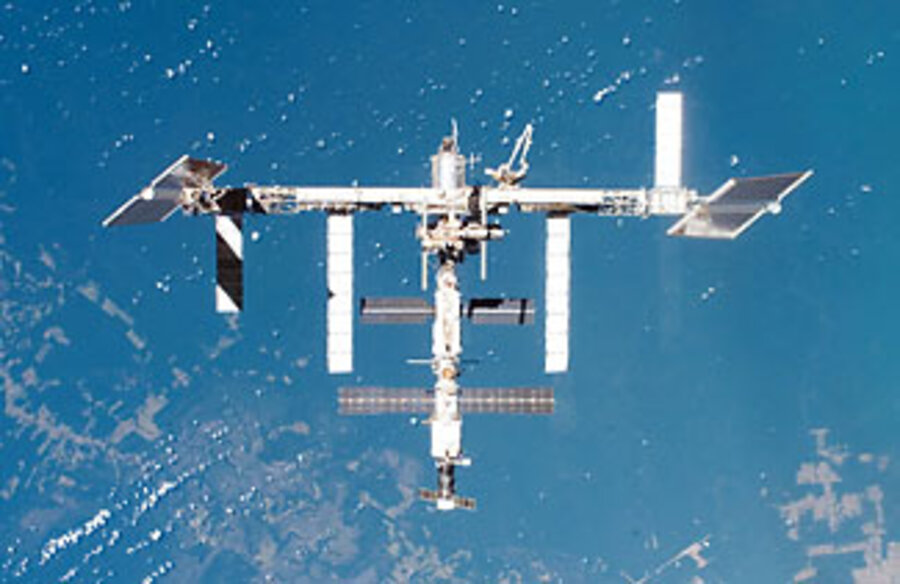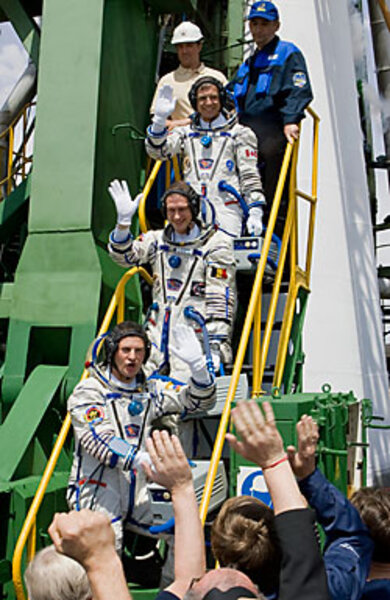Life aboard the International Space Station is about to become more chummy
Loading...
After 25 years, four make-overs, and a shift from Cold War icon to a truly international orbiting outpost, the International Space Station is about to reach a milestone: Its first full complement of six crew members.
On Friday a Russian Soyuz capsule is scheduled to arrive at the station bearing Russia's Roman Romanenko, Canada's Robert Thirsk, and the European Space Agency's Frank De Winne. They launched at 6:34 this morning Eastern Daylight Time into clear skies over the Baikonur Cosmodrome in Kazakhstan and are now playing catch-up with the space station.
Over the years, 173 people have spent time aboard the station – including six well-heeled tourists, as well as astronauts from 15 countries. Until now, however, the outpost has been formally staffed with at most three full-time crew members. For three years following the Columbia accident in 2003, the station only hosted a crew of two while the shuttle program recovered.
And for the first time, the station's crew will consist of representatives of all five major partners. When astronauts Romanenko, Thirsk, and De Winne move through the hatch and into the station, they will join astronauts from the US, Japan, and Russia.
"We've been looking forward to getting to this increment for a long, long time," says Dan Hartman, who manages space-station operations and integration for the National Aeronautics and Space Administration.
For Europe in particular, today's launch represents a turning point in its role on orbit. Through September, De Winne will serve as a flight engineer. But in October, he takes over as Europe's first space-station commander.
The moment has not been lost on Simonetta di Pippo, the European Space Agency's director of human spaceflight.
"Human spaceflight and exploration is gaining momentum, and we will be working for Europe to seize bigger opportunities in this field," she said.
As if to underscore the point, ESA announced last week that it had selected its first new crop of astronauts since 1992 – six future space explorers, culled from 8,413 applications.
From the astronauts' perspective, life is about to get far more chummy aboard the space station. Living and lab space have grown. So has the station's ability to generate enough electricity for a "family" of six and its power-hungry laboratories.
Indeed, the last hurdle station managers had to clear was trouble with the urine-processing unit, which helps convert liquid body waste into drinkable water.
A self-replenishing water system is critical to the station. Until now, the space shuttles have recharged the station's high-tech "aquifer" with each visit.
Once the shuttles cease operation, that source of drinking water evaporates. And while Russian, European, and Japanese resupply capsules could try to make up some of that lost water-transport capacity, mission managers have other cargo they need to send up to the station.
In some respects, the experience astronauts will face would be familiar to anyone with a large family, Canada's Thirsk suggests.
"Everyone knows what it's like to have the in-laws, family, and friends over for the holidays," he says. "There are line-ups at the bathroom. Meals have to be properly coordinated. There's line-ups for the use of the phone. Everyone loses personal space a little bit. But it's something we're willing to go through."
On the space station, close conditions will last far longer than a holiday visit.
From managing the hygiene station, trash, and stowage to ensuring everyone has a shot at the communications loop and their own bit of personal space, the crew will have to be far more disciplined than folks at home – almost like embracing a backpacker's "leave no trace" ethic at the end of each task. But, he adds, "We've all had that type of training, so we're well prepared for that."
As for language issues, Russia's Romanenko explains that over the years, space-station crew members have developed what they jokingly call Renglish, an English-Russian hybrid that serves crews well. Given the length of time crews train together – five years for the newly arriving trio – everyone has plenty of time to learn the lingo.
For the crew aboard the station the period running through October will be intense. Shuttle flights in June and in August will bring up additional structural pieces for the Japanese lab, as well as Node 3, now dubbed Serenity. Ultimately, it will serve as the station's utility closet – housing life-support systems, the sanitary facilities, and an exercise bike named after Stephen Colbert, host of Comedy Central's "Colbert Report."
In September Japan launches the first of its unmanned cargo craft, which is designed to stop just short of the station for a final helping hand from the station's robotic arm to dock it with the station. The crew will conduct two spacewalks.
The crew will either start or continue to tend some 98 science experiments spread among disciplines ranging from materials science to biomedicine and geophysics.






